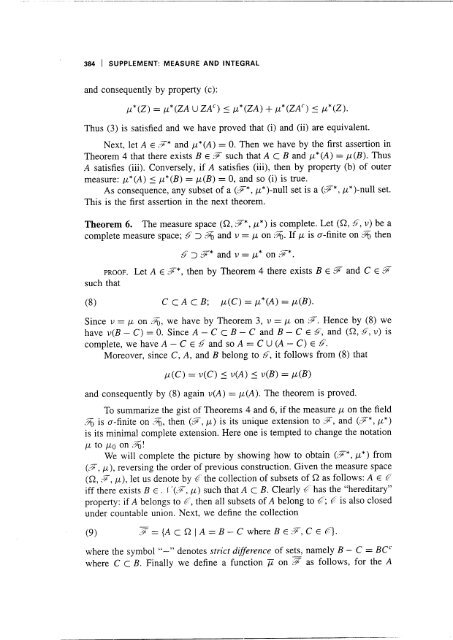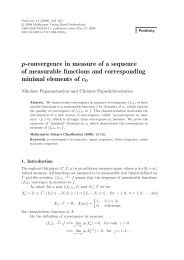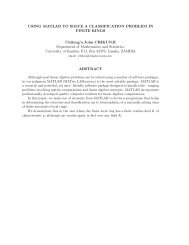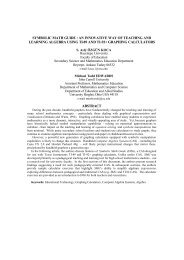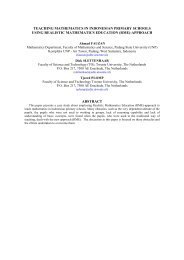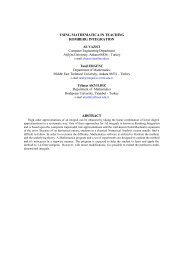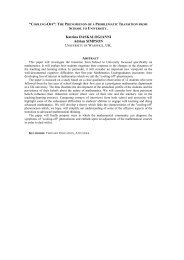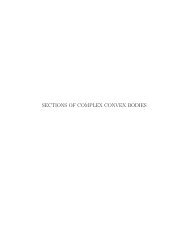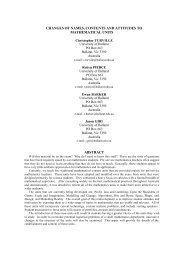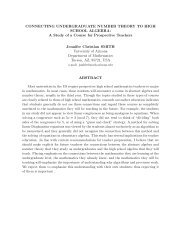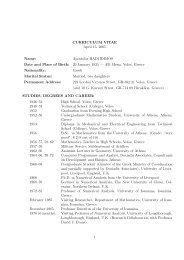- Page 2 and 3:
ACOURSE INPROBABILITYTHEORYTHIRD ED
- Page 4 and 5:
This book is printed on acid-free p
- Page 6 and 7:
vi I CONTENTS4 .3 Vague convergence
- Page 8 and 9:
Preface to the third editionIn this
- Page 10 and 11:
Preface to the second editionThis e
- Page 12 and 13:
Preface to the first editionA mathe
- Page 14 and 15:
PREFACE TO THE FIRST EDITION I xv(d
- Page 16 and 17:
Distribution function1 .1 Monotone
- Page 18 and 19:
1 .1 MONOTONE FUNCTIONS 1 3Example
- Page 20 and 21:
1 .1 MONOTONE FUNCTIONS 1 5havef I
- Page 22 and 23:
8 1 DISTRIBUTION FUNCTIONb ithe siz
- Page 24 and 25:
10 1 DISTRIBUTION FUNCTIONF2 - F ;
- Page 26 and 27:
12 ( DISTRIBUTION FUNCTIONThe next
- Page 28 and 29:
14 1 DISTRIBUTION FUNCTIONbecomes o
- Page 30:
Measure theory2 .1 Classes of setsL
- Page 33 and 34:
2 .1 CLASSES OF SETS 1 19and so = 6
- Page 35 and 36:
2.2 PROBABILITY MEASURES AND THEIR
- Page 37 and 38:
2 .2 PROBABILITY MEASURES AND THEIR
- Page 39 and 40:
2 .2 PROBABILITY MEASURES AND THEIR
- Page 41 and 42:
2 .2 PROBABILITY MEASURES AND THEIR
- Page 43 and 44:
2 .2 PROBABILITY MEASURES AND THEIR
- Page 45 and 46:
2 .2 PROBABILITY MEASURES AND THEIR
- Page 47 and 48:
2.2 PROBABILITY MEASURES AND THEIR
- Page 49 and 50:
3 .1 GENERAL DEFINITIONS 1 3 5of a
- Page 51 and 52:
3 .1 GENERAL DEFINITIONS 1 37Specif
- Page 53 and 54:
3 .1 GENERAL DEFINITIONS 1 39by (2)
- Page 55 and 56:
3 .2 PROPERTIES OF MATHEMATICAL EXP
- Page 57 and 58:
3 .2 PROPERTIES OF MATHEMATICAL EXP
- Page 59 and 60:
3 .2 PROPERTIES OF MATHEMATICAL EXP
- Page 61 and 62:
3 .2 PROPERTIES OF MATHEMATICAL EXP
- Page 63 and 64:
3.2 PROPERTIES OF MATHEMATICAL EXPE
- Page 65 and 66:
3 .2 PROPERTIES OF MATHEMATICAL EXP
- Page 67 and 68:
3 .3 INDEPENDENCE 1 533.3 Independe
- Page 69 and 70:
3 .3 INDEPENDENCE 1 55PROOF . We gi
- Page 71 and 72:
3 .3 INDEPENDENCE 1 57Corollary . I
- Page 73 and 74:
3 .3 INDEPENDENCE 1 59Then we haven
- Page 75 and 76:
3 .3 INDEPENDENCE 1 61in which ther
- Page 77 and 78:
3 .3 INDEPENDENCE 1 63We have thus
- Page 79 and 80:
3 .3 INDEPENDENCE I 65EXERCISES1 .
- Page 81 and 82:
3 .3 INDEPENDENCE I 67If do : {E~n
- Page 83 and 84:
4 .1 VARIOUS MODES OF CONVERGENCE 1
- Page 85 and 86:
4 .1 VARIOUS MODES OF CONVERGENCE I
- Page 87 and 88:
4 .1 VARIOUS MODES OF CONVERGENCE 1
- Page 89 and 90:
4 .2 ALMOST SURE CONVERGENCE; BOREL
- Page 91 and 92:
4 .2 ALMOST SURE CONVERGENCE; BOREL
- Page 93 and 94:
4.2 ALMOST SURE CONVERGENCE; BOREL-
- Page 95 and 96:
4 .2 ALMOST SURE CONVERGENCE ; BORE
- Page 97 and 98:
4 .2 ALMOST SURE CONVERGENCE; BOREL
- Page 99 and 100:
4 .3 VAGUE CONVERGENCE 1 85In this
- Page 101 and 102:
4 .3 VAGUE CONVERGENCE 1 87PROOF .
- Page 103 and 104:
4 .3 VAGUE CONVERGENCE ( 89By Sec .
- Page 105 and 106:
4.4 CONTINUATION 1 918. If g„ and
- Page 107 and 108:
4 .4 CONTINUATION 1 93that is linea
- Page 109 and 110:
4.4 CONTINUATION 1 95A family of p
- Page 111 and 112:
4 .4 CONTINUATION 1 97if X„ -+ X
- Page 113 and 114:
4 .5 UNIFORM INTEGRABILITY ; CONVER
- Page 115 and 116:
4 .5 UNIFORM INTEGRABILITY ; CONVER
- Page 117 and 118:
4.5 UNIFORM INTEGRABILITY ; CONVERG
- Page 119 and 120:
4 .5 UNIFORM INTEGRABILITY ; CONVER
- Page 121 and 122:
5 .1 SIMPLE LIMIT THEOREMS 1 107eve
- Page 123 and 124:
5 .1 SIMPLE LIMIT THEOREMS 1 109and
- Page 125 and 126:
5 .1 SIMPLE LIMIT THEOREMS 1 1 1 1r
- Page 127 and 128:
5.2 WEAK LAW OF LARGENUMBERS 1 1 1
- Page 129 and 130:
5.2 WEAK LAW OF LARGENUMBERS 1 1 1
- Page 131 and 132:
5.2 WEAK LAW OF LARGENUMBERS I 1 1
- Page 133 and 134:
5 .2 WEAK LAW OF LARGENUMBERS I 1 1
- Page 135 and 136:
5 .3 CONVERGENCE OF SERIES 1 12112.
- Page 137 and 138:
5 .3 CONVERGENCE OF SERIES 1 123whe
- Page 139 and 140:
5 .3 CONVERGENCE OF SERIES 1 1 2 5W
- Page 141 and 142:
5 .3 CONVERGENCE OF SERIES 1 127Thi
- Page 143 and 144:
5 .4 STRONG LAW OF LARGENUMBERS 1 1
- Page 145 and 146:
5 .4 STRONG LAW OF LARGENUMBERS 1 1
- Page 147 and 148:
5.4 STRONG LAW OF LARGENUMBERS 1 13
- Page 149 and 150:
5 .4 STRONG LAW OF LARGENUMBERS 1 1
- Page 151 and 152:
5.4 STRONG LAW OF LARGENUMBERS 1 13
- Page 153 and 154:
is an r cv) as follows co) (o) is c
- Page 155 and 156:
5 .5 APPLICATIONS 1 1 4 1PROOF . Su
- Page 157 and 158:
5 .5 APPLICATIONS 1 1 43null set Z
- Page 159 and 160:
5 .5 APPLICATIONS 1 1 45PROOF.Since
- Page 161 and 162:
5 .5 APPLICATIONS 1 1 4 7One should
- Page 163 and 164:
5 .5 APPLICATIONS 1 149Smile Borel,
- Page 165 and 166:
6.1 GENERAL PROPERTIES; CONVOLUTION
- Page 167 and 168:
6.1 GENERAL PROPERTIES ; CONVOLUTIO
- Page 169 and 170:
6 .1 GENERAL PROPERTIES ; CONVOLUTI
- Page 171 and 172:
CS6 .1 GENERAL PROPERTIES; CONVOLUT
- Page 173 and 174:
6 .1 GENERAL PROPERTIES ; CONVOLUTI
- Page 175 and 176:
x[ J6 .2 UNIQUENESS AND INVERSION 1
- Page 177 and 178:
6 .2 UNIQUENESS AND INVERSION 1 163
- Page 179 and 180:
6 .2 UNIQUENESS AND INVERSION 1 165
- Page 181 and 182:
I6 .2 UNIQUENESS AND INVERSION 1 1
- Page 183 and 184:
6 .3 CONVERGENCE THEOREMS I 169For
- Page 185 and 186:
6 .3 CONVERGENCE THEOREMS 1 171ther
- Page 187 and 188:
6.3 CONVERGENCE THEOREMS 1 173metri
- Page 189 and 190:
6 .4 SIMPLE APPLICATIONS I 175b > a
- Page 191 and 192:
6 .4 SIMPLE APPLICATIONS I 177k-1 j
- Page 193 and 194:
6 .4 SIMPLE APPLICATIONS 1 179Theor
- Page 195 and 196:
6 .4 SIMPLE APPLICATIONS 1 181then
- Page 197 and 198:
6 .4 SIMPLE APPLICATIONS 1 183We en
- Page 199 and 200:
6 .4 SIMPLE APPLICATIONS 1 185limit
- Page 201 and 202:
6 .5 REPRESENTATIVE THEOREMS 1 187c
- Page 203 and 204:
l6 .5 REPRESENTATIVE THEOREMS 1 189
- Page 205 and 206:
6 .5 REPRESENTATIVE THEOREMS 1 191(
- Page 207 and 208:
6 .5 REPRESENTATIVE THEOREMS I 193w
- Page 209 and 210:
6 .5 REPRESENTATIVE THEOREMS I 195E
- Page 211 and 212:
6 .6 MULTIDIMENSIONAL CASE; LAPLACE
- Page 213 and 214:
6 .6 MULTIDIMENSIONAL CASE ; LAPLAC
- Page 215 and 216:
6 .6 MULTIDIMENSIONAL CASE ; LAPLAC
- Page 217 and 218:
6 .6 MULTIDIMENSIONAL CASE; LAPLACE
- Page 219 and 220:
7Central limit theorem andits ramif
- Page 221 and 222:
7.1 LIAPOUNOV'S THEOREM l 207are "n
- Page 223 and 224:
7.1 LIAPOUNOV'S THEOREM 1 209the sa
- Page 225 and 226:
(D7.1 LIAPOUNOV'S THEOREM 1 211If1,
- Page 227 and 228:
7 .1 LIAPOUNOV'S THEOREM I 213and p
- Page 229 and 230:
7 .2 LINDEBERG-FELLER THEOREM 1 215
- Page 231 and 232:
7.2 LINDEBERG-FELLER THEOREM 1 217W
- Page 233 and 234:
7 .2 LINDEBERG-FELLER THEOREM 1 219
- Page 235 and 236:
7 .2 LINDEBERG-FELLER THEOREM 1 221
- Page 237 and 238:
7 .2 LINDEBERG-FELLER THEOREM 1 223
- Page 239 and 240:
(D if Sn /s'n does7.3 RAMIFICATIONS
- Page 241 and 242:
7.3 RAMIFICATIONS OF THE CENTRAL LI
- Page 243 and 244:
7 .3 RAMIFICATIONS OF THE CENTRAL L
- Page 245 and 246:
7 .3 RAMIFICATIONS OF THE CENTRAL L
- Page 247 and 248:
7 .3 RAMIFICATIONS OF THE CENTRAL L
- Page 249 and 250:
7 .4 ERROR ESTIMATION 1 2 35as n -~
- Page 251 and 252:
22x2x27 .4 ERROR ESTIMATION 1 23 7b
- Page 253 and 254:
7 .4 ERROR ESTIMATION l 23 9for the
- Page 255 and 256:
7 .4 ERROR ESTIMATION 1 24 1PROOF .
- Page 257 and 258:
7.5 LAW OF THE ITERATED LOGARITHM 1
- Page 259 and 260:
7 .5 LAW OF THE ITERATED LOGARITHM
- Page 261 and 262:
7 .5 LAW OF THE ITERATED LOGARITHM
- Page 263 and 264:
7 .5 LAW OF THE ITERATED LOGARITHM
- Page 265 and 266:
7 .6 INFINITE DIVISIBILITY 1 251amo
- Page 267 and 268:
7.6 INFINITE DIVISIBILITY 1 253The
- Page 269 and 270:
7 .6 INFINITE DIVISIBILITY 1 255Sin
- Page 271 and 272:
7 .6 INFINITE DIVISIBILITY 1 257is
- Page 273 and 274:
7 .6 INFINITE DIVISIBILITY 1 259Let
- Page 275 and 276:
7 .6 INFINITE DIVISIBILITY 1 261ch
- Page 277 and 278:
8Random walk8 .1 Zero-or-one lawsIn
- Page 279 and 280:
8 .1 ZERO-OR-ONE LAWS 1 2 65Each S2
- Page 281 and 282:
8 .1 ZERO-OR-ONE LAWS 1 2 6 71 clea
- Page 283 and 284:
8.1 ZERO-OR-ONE LAWS 1 269Applying
- Page 285 and 286:
8 .2 BASIC NOTIONS 1 2 7 1have, how
- Page 287 and 288:
8 .2 BASIC NOTIONS 1 273Instead of
- Page 289 and 290:
8 .2 BASIC NOTIONS 1 275PROOF . The
- Page 291 and 292:
8.2 BASIC NOTIONS 1 27 7Theorem 8.2
- Page 293 and 294:
8.3 RECURRENCE I 2 7 9DEFINrrION .
- Page 295 and 296:
8.3 RECURRENCE 1 28 1by the previou
- Page 297 and 298:
8.3 RECURRENCE 1 2 831 A> U ( )Cm n
- Page 299 and 300:
8 .3 RECURRENCE 1 285< 2(1 - r) 2 +
- Page 301 and 302:
8 .3 RECURRENCE 1 2 8 7is a strictl
- Page 303 and 304:
8 .4 FINE STRUCTURE 1 289with the u
- Page 305 and 306:
8 .4 FINE STRUCTURE 1 29 1rearrange
- Page 307 and 308:
8.4 FINE STRUCTURE 1 293(D) If c,(,
- Page 309 and 310:
8.4 FINE STRUCTURE I 2 9 5PROOF . I
- Page 311 and 312:
8 .4 FINE STRUCTURE 1 2 9 7for 0 <
- Page 313 and 314:
8 .5 CONTINUATION 1 299(necessarily
- Page 315 and 316:
8 .5 CONTINUATION 1 30 1and consequ
- Page 317 and 318:
8 .5 CONTINUATION 1 3 0 3Lemma .For
- Page 319 and 320:
8 .5 CONTINUATION 1 3 0 5PROOF . Le
- Page 321 and 322:
8 .5 CONTINUATION 1 307implies JT(M
- Page 323 and 324:
8 .5 CONTINUATION 1 309The latter p
- Page 325 and 326:
9 .1 BASIC PROPERTIES OF CONDITIONA
- Page 327 and 328:
9 .1 BASIC PROPERTIES OF CONDITIONA
- Page 329 and 330:
9 .1 BASIC PROPERTIES OF CONDITIONA
- Page 331 and 332:
9 .1 BASIC PROPERTIES OF CONDITIONA
- Page 333 and 334:
9 .1 BASIC PROPERTIES OF CONDITIONA
- Page 335 and 336:
9 .1 BASIC PROPERTIES OF CONDITIONA
- Page 337 and 338:
9.2 CONDITIONAL INDEPENDENCE ; MARK
- Page 339 and 340:
9 .2 CONDITIONAL INDEPENDENCE; MARK
- Page 341 and 342:
9 .2 CONDITIONAL INDEPENDENCE; MARK
- Page 343 and 344:
9.2 CONDITIONAL INDEPENDENCE ; MARK
- Page 345 and 346:
9 .2 CONDITIONAL INDEPENDENCE ; MAR
- Page 347 and 348: 9 .2 CONDITIONAL INDEPENDENCE ; MAR
- Page 349 and 350: 9 .3 BASIC PROPERTIES OF SMARTINGAL
- Page 351 and 352: 9.3 BASIC PROPERTIES OF SMARTINGALE
- Page 353 and 354: 9.3 BASIC PROPERTIES OF SMARTINGALE
- Page 355 and 356: 9 .3 BASIC PROPERTIES OF SMARTINGAL
- Page 357 and 358: 9 .3 BASIC PROPERTIES OF SMARTINGAL
- Page 359 and 360: 9 .3 BASIC PROPERTIES OF SMARTINGAL
- Page 361 and 362: 9 .4 INEQUALITIES AND CONVERGENCE 1
- Page 363 and 364: 9 .4 INEQUALITIES AND CONVERGENCE 1
- Page 365 and 366: 9 .4 INEQUALITIES AND CONVERGENCE 1
- Page 367 and 368: 9 .4 INEQUALITIES AND CONVERGENCE 1
- Page 369 and 370: 9 .4 INEQUALITIES AND CONVERGENCE 1
- Page 371 and 372: 9 .4 INEQUALITIES AND CONVERGENCE 1
- Page 373 and 374: 9 .4 INEQUALITIES AND CONVERGENCE 1
- Page 375 and 376: 9.5 APPLICATIONS 1 361PROOF. Let A
- Page 377 and 378: 9 .5 APPLICATIONS 1 363extension of
- Page 379 and 380: 9.5 APPLICATIONS 1 365(V)The strong
- Page 381 and 382: 9.5 APPLICATIONS 1 3 6 7But it is t
- Page 383 and 384: 9 .5 APPLICATIONS 1 369We have ther
- Page 385 and 386: 9 .5 APPLICATIONS ( 3712. Suppose t
- Page 387 and 388: 9 .5 APPLICATIONS 1 373is due to Mc
- Page 389 and 390: Supplement : Measure andIntegralFor
- Page 391 and 392: I CONSTRUCTION OF MEASURE 1 377The
- Page 393 and 394: 1 CONSTRUCTION OF MEASURE 1 379It f
- Page 395 and 396: 2 CHARACTERIZATION OF EXTENSIONS 1
- Page 397: 2 CHARACTERIZATION OF EXTENSIONS 1
- Page 401 and 402: 3 MEASURES IN R 1 387Now we use Def
- Page 403 and 404: 3 MEASURES IN R 1 389The right-cont
- Page 405 and 406: 3 MEASURES IN R 1 39 1Therefore the
- Page 407 and 408: 3 MEASURES IN R 1 393If we intersec
- Page 409 and 410: 4 INTEGRAL 1 395has cardinal 2C whi
- Page 411 and 412: 4 INTEGRAL 1 397The order of summat
- Page 413 and 414: n4 INTEGRAL 1 399If W E A k , then
- Page 415 and 416: 4 INTEGRAL 1 401Theorem 9 . Let If,
- Page 417 and 418: 4 INTEGRAL I 403inThe three theorem
- Page 419 and 420: 4 INTEGRAL 1 405To prove this we ma
- Page 421 and 422: 5 APPLICATIONS 1 407Curiously, the
- Page 423 and 424: 5 APPLICATIONS 1 409When Uk is gene
- Page 425 and 426: log ~ _ .d~ f~ - dx = log ,5 APPLIC
- Page 427 and 428: General bibliography[The five divis
- Page 429 and 430: IndexAbelian theorem, 292Absolutely
- Page 431 and 432: INDEX 1 417GGambler's ruin, 343Gamb
- Page 433: INDEX 1 419improper, infinite, 410p


